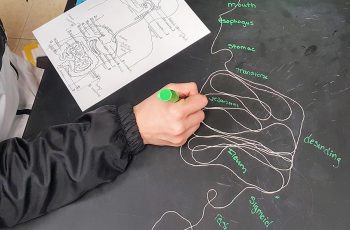Tag: model
-

Enzyme and Substrate Concentrations
Students examine graphical models of enzyme and substrate interactions showing how the speed of reactions changes with concentration.
-

Investigating Sea Turtles and Sex Determination
Create a model of a turtle nest to record temperatures at different depths. The temperature of the nest will determine whether turtles are male or female.
-

Labeling Exercise on the Sliding Filament Model
Learn the steps of the sliding filament model of muscle contraction with this labeling exercise. Two versions and answers are included.
-

Forensics Activity: The Mystery of the Bones
Construct a skeleton from paper to model how forensic scientists use clues from the bones to determine sex, gender, age, height, and race.
-

DNA Model – Cut and Paste Nucleotides
This digital modeling activity allows students to build a DNA model by dragging the individual parts into a completed diagram
-

Sliding Filament Coloring
Step by step guide of the sliding filament model;, contraction starts with a nerve impulse and ends with muscle fibers shortening. Students color the diagram.
-

Investigation: Model Enzyme Activity with Toothpicks
Use toothpicks to model enzymes. Explore substrate and enzyme concentrations by changing toothpick numbers. Model competitive inhibition by taping fingers.
-

Investigation: How Do Insects Move?
Have you ever thought about how insects with 6 legs actually crawl? Human movement on two legs is pretty simple: left-right-left-right, but all insects have 6 legs attached to a thorax. In this activity, I ask students to observe an insect closely, usually a dubia roach.
-

Measuring Biodiversity Using Beans
Students analyze a community of beans (pinto, lima, navy) to determine the richness, abundance, and biodiversity index of two communities.
-

Modeling the Alimentary Canal
In this activity, students use string to model the gastrointestinal tract as a scale model. I’ve noticed that students do have difficulty with the concept of scaling, which is one of the crosscutting concepts listed in the NGSS. The directions give students measurements for a 1/3 scale model, the human alimentary canal is about 9…
-

Modeling Independent Assortment & Dihybrid Crosses
Students examine how two traits are inherited, revealing that each allele has an equal chance of being passed on to the next generation, the principle of independent assortment.
-

Investigation: Modeling Heredity with Popsicle Sticks
In this activity, you will use popsicle sticks to model the process of gamete formation and the combining of sperm and egg to create offspring. Results of the simulation can then be compared to Punnet square expected results. Popsicles should be made in advance, the set contains a male and female set with the genotypes…
-

Construct a DNA Model Using Marshmallows
Use marshmallows and toothpicks to construct a model of DNA. Mini marshmallows represents the nucleotides, large marshmallows represent deoxyribose.
-

Case Study: John Snow and the Origin of Epidemiology
This case study explores a time before the Germ Theory when doctors were uncertain how disease was spread. Current models, such as the humoral or miasma model could not fully explain how cholera infected some households, but not others. This case story explores London, England in 1854 after an outbreak of cholera which had…
-

Investigation: Modeling Diffusion
This inquiry investigation requires students to cut agar into 3 shapes (small, medium, large) and compare the rates of diffusion.

